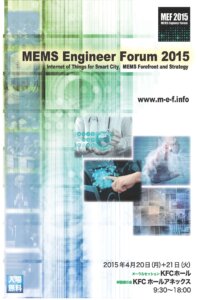MEMS sensors, and the Internet of Things data they feed to the cloud, are being called on to jumpstart the world’s third largest economy.
The economic revitalization strategy being instituted by Japanese Prime Minister Shinzo Abe, and now being carried out in Japan under the moniker “Abenomics,” consists of Three Arrows: the First Arrow is aggressive monetary policy; the Second Arrow is flexible fiscal strategy; and the Third Arrow is new growth strategies.
 Dr. Kazuo Kyuma, Executive Member of the Council for Science, Technology and Innovation, Cabinet Office, Government of Japan, opened the MEMS Engineer Forum 2015 in Tokyo, Japan, on April 20 2015 with a very strong talk about how IoT innovation by MEMS has become a fundamental part of the science, technology, and innovation policy of Japan, on the predicate that sustainable economic growth for Japan can be realized by the creation of innovation.
Dr. Kazuo Kyuma, Executive Member of the Council for Science, Technology and Innovation, Cabinet Office, Government of Japan, opened the MEMS Engineer Forum 2015 in Tokyo, Japan, on April 20 2015 with a very strong talk about how IoT innovation by MEMS has become a fundamental part of the science, technology, and innovation policy of Japan, on the predicate that sustainable economic growth for Japan can be realized by the creation of innovation.
That’s a Japan I hadn’t much visited before – one that makes disruptive innovation part of its official industrial policy. What a change since my last time in Tokyo in late 2010.
Dr. Kyuma, referencing the work of Clayton Christensen, father of the disruptive innovation concept (“…a process by which a product or service takes root initially in simple applications at the bottom of a market and then relentlessly moves up market, eventually displacing established competitors.”), makes one think this particular moment in Japanese history could be something like the Deming moment / movement Japan experienced in the 1950s.
(Per Wikipedia, “[W. Edwards] Deming is best known for his work in Japan after WWII, particularly his work with the leaders of Japanese industry. That work began in August 1950 at the Hakone Convention Center in Tokyo when Deming delivered a seminal speech on what he called Statistical Product Quality Administration. Many in Japan credit Deming as the inspiration for what has become known as the Japanese post-war economic miracle of 1950 to 1960, when Japan rose from the ashes of war to become the second most powerful economy in the world in less than a decade founded on the ideas Deming taught.”)
Japan aims to become the world’s most innovation-friendly country, and the vehicle for doing that is via the recently (May 2014) reorganized Council for Science, Technology, and Innovation, of which Dr. Kyuma is an executive member.
The attributes of an ideal nation, an ideal Japan, said Dr. Kyuma, are these: possessing international competiveness and delivering sustainable growth, while ensuring the progress of society; ensuring that its citizens feel safe, secure, and affluent and ensuring they realize a good quality of life; proactively approaching global challenges, including natural disasters and climate change, while contributing to progressive sustainable development throughout the world.
Japan thinks it can achieve those ideal conditions in the 2025 – 2035 timeframe, ten to twenty years from now.
I think there’s a strong overlap between what Dr. Kyuma said in his talk at MEF 2015 and the goals of the TSensors Foundation, which says that “One of the most rewarding effects of a trillion [MEMS] sensors will be life-changing global advancements and improvements addressing elimination of the biggest world’s problems, such as hunger, lack of medical care, pollution, lack of water and energy, as well as improvement of quality of life for all.”
According to Dr. Kyuma, the IoT is one of the important areas / engines of innovation Japan wants to “own,” and MEMS is one of the key technologies for the IoT, because MEMS (smartly) connects “things” to the cloud, because MEMS changes hardware, or physical things, to virtual IoT things, and because MEMS offers the chance for IoT “thing” data to be open to all.
The concept the organizers had in mind for MEF 2015 was to assemble of program of talks on the theme of Internet of Things for Smart City, MEMS Forefront, and Strategy.
There were many talks along those lines in the two days of the Forum, including a concluding panel discussion on “The Ecosystem for MEMS R&D toward Commercialization and Industrialization.” About these I will have more to report in a follow-up post.
 It is an enormous responsibility to make plans for the future of a country, as Dr. Kyuma and his colleagues are doing; Abenomics is now the institutional basis for the revitalization of the Japanese economy.
It is an enormous responsibility to make plans for the future of a country, as Dr. Kyuma and his colleagues are doing; Abenomics is now the institutional basis for the revitalization of the Japanese economy.
Reestablishing Japan’s economic and technological competitiveness in the next decade or two requires a quiver of arrows aimed at disrupting the status quo. Silicon Valley thinking in the Land of the Rising Sun. And MEMS sensors linked to the IoT, one of the arrows of Japan’s new growth strategy, is being counted on to be a bullseye arrow.
From Pittsburgh, PA, thanks for reading. ~PFW























